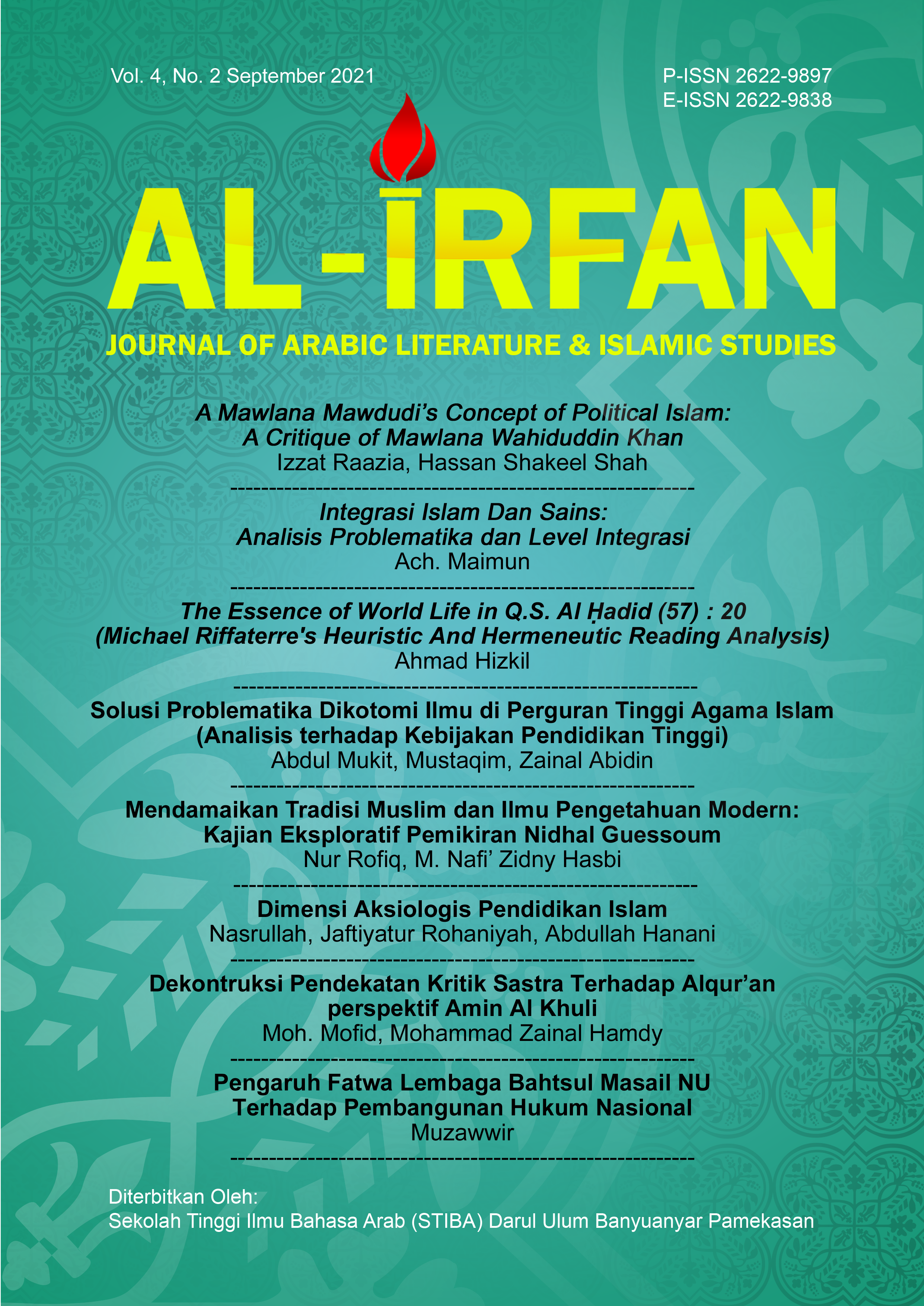The Essence of World Life in Q.S. Al Ḥadid (57) : 20
(Michael Riffaterre's Heuristic And Hermeneutic Reading Analysis)
DOI:
https://doi.org/10.36835/alirfan.v4i2.4756Keywords:
word life, heuristic, hermeneutic, RIffaterre, al-hadid 57:20Abstract
This study aims to reveal the the essence of world life described in Q.S Al Hadid (57): 20 based on Michael RIffaterre's heuristic and hermeneutic reading. This research is included in the descriptive-qualitative research by making Q.S Al Hadid (57): 20 as the object of research as well as the source of the data. The theory used is Michael Riffaterre's semiotic theory which introduces heuristic and hermeneutic reading methods in interpreting a text. The data collection technique is a listening and note-taking technique. Meanwhile, the data analysis technique is descriptive-analytic. The results of this study indicate that the parable of the world mentioned in Q.S. Al Hadid (57): 20 is the essence of the real life of the world. That the life of this world is just a game and a negligent joke. The parables of the world are a form of displacing of meaning as in Riffaterre's theory. The regularity of the editors in every parable of the world is a picture of the phase of human life from childhood to adulthood and then death. This meaning is part of the form of creating meaning. The intertextuality of Q.S Al Hadid (57): 20 shows that this verse is not the only one that describes the nature of the life of the world but is also found in Q.S. Al-An'am(6): 32, Q.S. Muhammad(47): 36, and Q.S. Ali Imran(3): 14.References
Al-Baqi, Muhammad Fuad abd. Al-Mu’jam Al-Mufahras Li AlfÄẓ Al-Quran AlKarÄ«m. Kairo: Dar al-Hadis, 2007.
Al-Qurtubi, Muhammad bin Ahmad bin Abi Bakr. “JÄmi’ Li AḥkÄm Al-Quran.†In Jilid 20. Beirut: ar-Risalah, 2006.
Al-Sajjar, Ahmad bin Abdul Karim al Hasawi. Pemantap Hati Mutiara Kata Dan Nasihat Al-ImÄm ḤabÄ«b ‘Abdullah Bin Alawi Al-ḤaddÄd. Bandung: Pustaka Hidayah, 2002.
Arkoun, Muhammad. Kajian Kontemporer Al-Quran, Terj. Hidayatullah. Bandung: Pustaka Hidayah, 1998.
Dkk, M. Quraish Shihab. Ensiklopedia Al-Quran Kajian Kosa Kata. Jakarta: Lentera Hati, 2007.
Hizkil, Qalyubi dan. “Surah Al-Qadr Dalam Tinjauan Stilistika.†Nady Al-Adab: Jurnal Bahasa Arab 18, no. 1 (2021).
Imran, Ali. Semiotika Al-Quran: Metode Dan Aplikasi Terhadap Kisah Yusuf. Yogyakarta: Teras, 2011.
Maulana, Lutfi. “Semiotika Michael Riffaterre (Analisis Pembacaan Heuristik-Hermeneutik Atas Q.S. Ali Imran (3): 14).†QOF: Jurnal Studi Al-Qur’an dan Tafsir 3, no. 1 (2019).
Moeleong, Lexy J. Metodologi Penelitian Kualitatif. Bandung: PT. Remaja Rosda Karya, 2011.
Pradopo, Rachmat Djoko. Beberapa Teori Sastra, Metode Kritik Dan Penerapannya. Yogyakarta: Pustaka Pelajar, 2008.
Ratih, Rina. Teori Dan Aplikasi Semiotik Michael Riffaterre. Yogyakarta: Pustaka Pelajar, 2017.
Ridwan, Aulia Farih. “Skripsi Tafsir Ayat Poligami Dalam Al-Manar (Analsis Semiotika Superreader Terhadap An-Nisa Ayat 3 Dan 129).†UIN Sunan Kalijaga Yogyakarta, 2019.
Shihab, M. Quraish. “Tafsir Al-Mishbah.†In Vol. 14. Jakarta: Lentera Hati, 2003.
———. Tafsir Al-Quran Al-Karīm; Tafsir Atas Surat-Surat Pendek Berdasarkan Urutan Turunnya Wahyu. Jakarta: Pustaka Hidayah, 1997.
Solekhatun, Siska. “Skripsi Hayah (Kehidupan) Dalam Al Quran(Kajian Semantik).†UIN Sunan Kalijaga Yogyakarta, 2017.
Taufiq, Wildan. Semiotika Untuk Kajian Sastra Dan Al-Quran. Bandung: Yrama Widya, 2016.
Downloads
Published
How to Cite
Issue
Section
License
Copyright (c) 2021 Ahmad Hizkil

This work is licensed under a Creative Commons Attribution 4.0 International License.
Lisensi :
Al-Irfan: Journal of Arabic Literature and Islamic Studies is published under conditions Creative Commons Attribution 4.0 International License / CC BY 4.0 This license permits anyone to copy and redistribute this material in any form or format, modify, modify, and make derivative works of this material for any purpose, including commercial purposes, so long as they credit the author for the original work.











